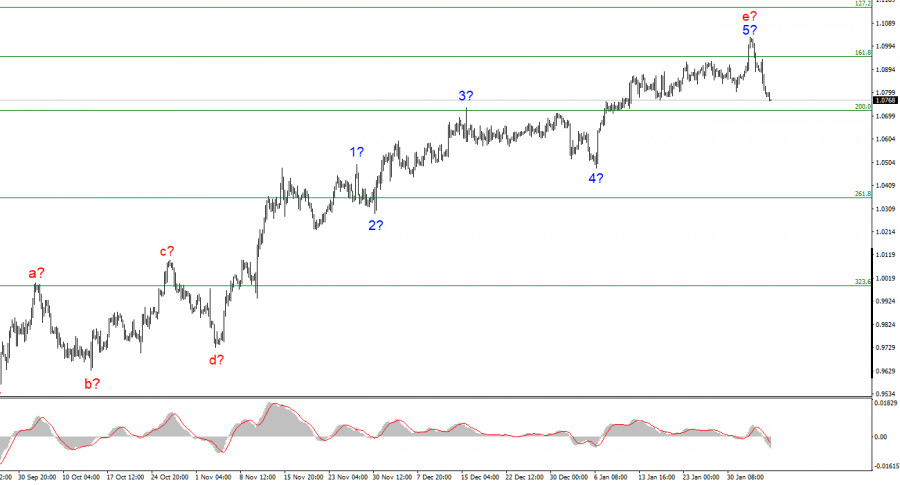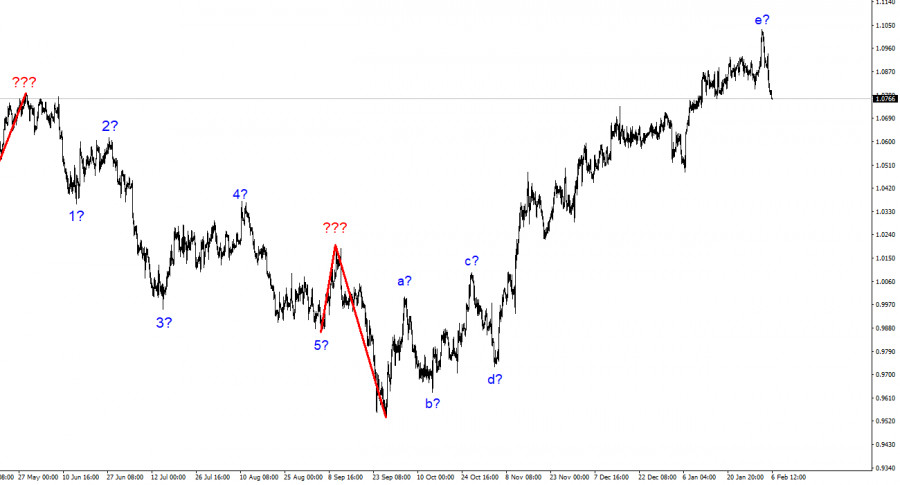

The wave pattern for the euro/dollar pair on the 4-hour chart hasn't moved at all recently, which is excellent because it means we know how the situation might change. Although its amplitude is better suited for the impulse section of the trend, the upward section of the trend has been corrected. The wave pattern a-b-c-d-e that we were able to obtain has a significantly more complex wave e than the other four waves. The development of this structure is complete, and wave e turned out to be far longer than all prior waves if the wave used today is accurate. I still anticipate a significant decrease in the instrument because at least three waves are anticipated to be built down. The demand for the euro was persistently high throughout the first few weeks of 2023, and during this time the instrument was only able to move significantly from previously established peaks. The US currency did, however, manage to avoid market pressure at the beginning of February, and the present detachment of quotes from the peaks reached can be viewed as the start of a new downward trend section, which I was simply hoping for. I hope that the current news environment and market sentiment will not impede the formation of a downward set of waves this time.
On Friday, the euro/dollar pair lost 115 basis points, for a total loss of more than 200 over the previous two days. The market responded in this way to the ECB, Fed, and labor market statistics. If the outcomes of the ECB and Fed meetings might be interpreted differently and lead to different conclusions, Friday's economic numbers did not provide that opportunity. I'll just quickly remind you. The Nonfarm Payrolls report, which is the most crucial news of the day, came in at 517K, significantly exceeding market forecasts. Additionally, the December value increased by 260K. Instead of increasing to 3.6-3.7%, the unemployment rate decreased to 3.4%. The non-manufacturing sector's business activity index increased to 55.2 and left the "negative zone." Therefore, the demand for US currency could only rise as a result of all the most significant reports of the day. Naturally, the market could have disregarded these data, as it has frequently recently, but the "fairy tale of the euro currency" could not persist indefinitely.
The development of the upward trend section has been significantly delayed even based on wave patterns. I had mentioned how excessively high the demand for the euro has been in recent months. However, the conditions at the end of the previous week ultimately gave sellers the required momentum, and the pair - the chance to create a downward trend section. As a result, I anticipate the pair to decrease despite all upcoming events, news, and economic reports. In my opinion, the pair might very well reach 4 or 5 digits in the upcoming weeks. In the relatively longer future, market mood and the ECB and Fed's plans for monetary policy will once again be important factors. After the development of the trend's corrective part is finished, development on a new, upward trend will likely start. If the euro's news backdrop is poor, we might observe a challenging downward correction or an impulse one.

I draw the conclusion that the upward trend section's development is finished based on the analysis. As a result, sales with targets close to the Fibonacci level of 1.0350 (261.8%) can now be taken into consideration. There is still a chance that the upward section of the trend will become much more complicated. However, almost for the first time in recent weeks, a picture that can be regarded as the start of the first downward wave as a part of a new trend segment is visible on the chart.
On the previous wave chart, the upward trend section's wave pattern has become longer but is likely finished. The a-b-c-d-e pattern is most likely represented by the five upward waves we observed. The pair has the potential to drop a further 300–400 basis points since the formation of a bearish trend section may have already started.